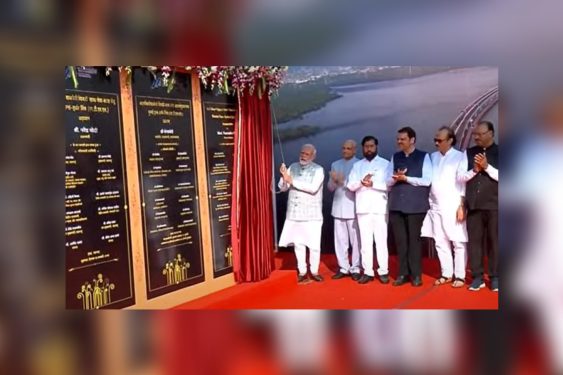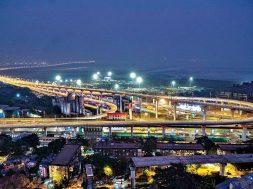Atal Setu: The longest sea bridge in India

“Atal Setu is a classic proof of India’s commitment to progress and connectivity. This groundbreaking infrastructure marvels the nation and will propel it into a future of unprecedented economic prosperity and seamless mobility.”
In a momentous event for India’s architectural landscape, Prime Minister Narendra Modi inaugurated the Atal Bihari Vajpayee Sewri-Nhava Sheva Atal Setu, formerly recognised as the Mumbai Trans Harbour Link (MTHL), on January 12. Maharashtra Chief Minister Eknath Shinde and Deputy Chief Ministers Devendra Fadnavis and Ajit Pawar participated in this historic occasion.
Spanning 16.5 kilometres over the sea and 5.5 kilometres on land, Atal Setu is a testament to architectural excellence. The materials used surpass iconic structures like the Eiffel Tower, and the construction under the guidance of the Mumbai Metropolitan Region Development Authority (MMRDA) on an Engineering Procurement Contract (EPC) basis promises a new era of connectivity and accessibility. The MTHL connects South Mumbai to the new Navi Mumbai airport and the Mumbai-Pune Expressway, elevating connectivity and reducing travel times.
Financed at a cost exceeding ₹17,840 crore, with substantial support from the Japan International Cooperation Agency, Atal Setu exemplifies international partnerships fostering India’s architectural growth. Atal Setu’s primary goal is significantly reducing travel time and fuel costs. Connecting Sewri in Mumbai to Chirle in Navi Mumbai will cut travel time from two hours to just 15 to 20 minutes, resulting in substantial fuel cost savings of approximately ₹500 per journey. This aligns with the government’s vision for sustainable and cost-effective architectural solutions. Laid as the foundation stone by the Prime Minister in December 2016, this project signifies a transformative phase in India’s architectural landscape.
The project involved leading construction firms, with GR Infraprojects (GRIL) and Gawar Constructions participating in the operations and maintenance (O&M) contract bidding process. The careful selection of an O&M partner underscores the industry’s commitment to delivering quality architectural infrastructure.

Beyond its immediate architectural benefits, Atal Setu is poised to transform the real estate sector, appreciating property prices and catalysing growth, particularly in areas like Panvel and Ulwe. It is set to democratise the real estate market, making regions once considered less desirable major centres of Mumbai’s architectural landscape.
Atal Setu is part of a comprehensive architectural development strategy, including constructing a 337 km metro network, operational segments, and upcoming expansions in 2023-2024. This integrated architectural approach is expected to impact property prices and drive significant real estate growth positively, reshaping the city’s architectural landscape.
Leading up to Atal Setu’s inauguration, Unmesh Sharad Wagh, IRS, Chairman in charge at Jawaharlal Nehru Port Authority (JNPA), emphasised the bridge’s significance in enhancing cargo transit times and logistical efficiency. He expressed optimism about reduced transportation time, a smaller carbon footprint, and increased connectivity, leading to new trade opportunities and investments in warehousing and logistics infrastructure.

Anshuman Magazine, Chairman & CEO – India, South-East Asia, Middle East & Africa, CBRE, stated, “Mumbai Trans Harbour Link is a historic leap in India’s infrastructure landscape. The bridge will reduce distance and accelerate the region’s economic growth. MTHL is poised to be a game-changer, intricately linking the Mumbai Pune Expressway to fortify connectivity between Maharashtra’s key cities. MTHL will have a monumental impact, strengthening new supply chains and connectivity between Mumbai and other cities. The strategic location promises to decongest the city and streamline the flow of materials finished goods, and labour. The impact of MTHL will extend beyond seamless mobility and include the real estate realm, ushering in a boom with upcoming residential projects and interconnected growth”.
Sanjay Dutt, Managing Director of Tata Realty & Infrastructure, looks forward to Prime Minister Narendra Modi inaugurating the 21.8-km Mumbai Trans Harbour Link (MTHL), which will connect Sewri in South Mumbai to Chirle near Navi Mumbai. “I am looking forward to driving on it in a pollution-free environment when I travel to the other side of the city,” Dutt says about the project that will see Mumbai taking another giant step towards better road connectivity. Besides lane driving and wider roads, the absence of traffic jams should be the icing on the cake, Dutt adds.
The Mumbai Metropolitan Development Authority (MMRDA) estimates that 70,000 vehicles will use the link daily. The six-lane link has been divided into three construction parts comprising 10.38 km developed by the L&T-IHI consortium, 7.807 km by Daewoo-Tata JV, and 3.6 km by L&T.

The link developers are proud of what they have created for obvious reasons. “We have brought the cities of Mumbai and Navi Mumbai closer, boosting economic growth, reducing carbon footprint and, most importantly, easing the traffic woes of Mumbaikars,” says SV Desai, whole-time Director & Senior Executive Vice President (Civil Infrastructure) at L&T.
Niranjan Hiranandani, Managing Director of Hiranandani group, says the link will throw up land parcels on the other side of the city (near Navi Mumbai), which is half the size of Mumbai. “Developers can develop a lot of new projects there now,” Hiranandani says, adding that Navi Mumbai Airport, Naina (Navi Mumbai Airport Influence Notified Area), and others will be half an hour from the mainland.
With the development of Nhava Sheva port, more than passenger movement, cargo movement would be much better, says renowned architect Shashi Prabhu, Founder of Shashi Prabhu & Associates, as “the port will now be closer to the city.” So, come Friday, get ready for Mumbai Next. With the Atal Setu poised to reshape the region’s landscape, Maharashtra braced itself for a new era of connectivity, economic prosperity, and infrastructural marvels.
339
Cookie Consent
We use cookies to personalize your experience. By continuing to visit this website you agree to our Terms & Conditions, Privacy Policy and Cookie Policy.








